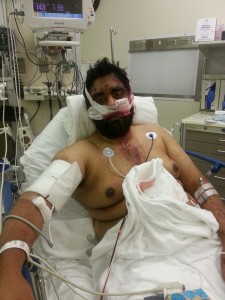Caustic acids have been a weapon of choice for attackers in parts of Africa, in Vietnam, India and other developing countries for more than four decades. The acid attack – where a person simply throws the substance on the victim – has have been traditionally used as a convenient weapon to settle interpersonal disputes. Where firearms have often been used in acts of interpersonal violence in the United States, strict gun control laws, and the fact that battery acid is cheap and readily available has often led people to use this alternative and devastating means of harming others in many developing countries.
An acid attack is easy to carry out, exceedingly painful, and can leave brutal injuries including blindness, horrific disfigurement as well as severe physical and emotional scarring. As with attacks with knives and firearms, an acid attack is sometimes fatal. Acid attacks are difficult to prevent using physical security measures because acid can be carried in a wide variety of containers and cannot easily be detected by metal detectors and security X-ray equipment.
While many Americans had not heard of the use of acid as a weapon until four American tourists were attacked with acid in France recently, it is likely that acid attacks will become well-known in the U.S. in the future. One reason for this is the increased media attention of acid attacks by American media. The use of acid attacks as a weapon of choice by terrorists also increases the risk that terrorists will opt to use acid for attacks. Al Qaeda has used acid to attack school girls and has successfully used the threat of acid attacks to intimidate girls who wish to attend school in Afghanistan.
The Acid Attack as a Rising International Trend
Perhaps the greatest indicator that acid attacks could become problematic in the U.S. is the rapid spread of this attack method in Europe. For example, the use of acid as a weapon has increased dramatically in with an estimated 1,800 acid attacks in London in recent years. Gang members, dangerously mentally ill attackers, people involved in bar fights and school children have increasingly turned to acid to carry out terrifying attacks. While I pray that I am wrong, in my experience, we are but one heavily publicized acid attack away from seeing the types of attacks that have become increasingly common in both developing and developed nations. Should this occur, we can anticipate a sudden frenzy similar to what we have seen with anthrax attacks and active shooter events with similarly ineffective solutions.
A solid approach to school violence prevention includes a variety of prevention measures that can be effective in reducing the risk of acid attacks. This is because an effective approach can reduce the risk of violence regardless of the type of weapon used. For example, efforts to reduce fights, control gang activity and student threat, evaluation and management efforts can all reduce the risk of violence regardless of weapon type. To a lesser extent, proper emergency planning provides a broad enough array of emergency protocols to help school staff respond to such an attack. As with firearm and knife attacks, having room clear and reverse evacuation protocols are two important examples of protocols that can help staff address an acid attack in an inside setting or an attack outside of the building.

As we describe in our book Staying Alive, there are many other types of dangerous attacks besides firearms.
Other alternative attack methods, such as mass casualty edged weapons assaults, the use of fire as a weapon, and attacks where vehicles are used to run over victims, also demand our attention. In this same vein, the use of commonly available acids as a weapon is also of increasing concern. Fortunately, holistic prevention and preparedness approaches can help to address these frightening events.
Any prevention and preparedness measures that are heavily focused on a single attack method such as active shooter events are subject to becoming obsolete in the wake of a single frightening and well-publicized attack. A proper array of prevention and preparedness approaches will offer a reasonable degree of protection regardless of the type of weapon used. Our research for the upcoming Cognella textbook Extreme Violence – Preventing and Preparing for Active Shooter, Active Killer, Hate Crimes, and Acts of Terrorism indicates that acid attacks are worthy of our attention as part of the all-hazards
approach to school security and emergency preparedness efforts.
Warning: The following video is graphic
This video was taken during the Station Nightclub fire in Rhode Island in 2003. It shows just how quickly a small fire can spread and cause panic. The effects of people being stuck in the doorway are similar to accounts from other major fire disasters that we are aware of, as well as many other incidents involving mass panic. This video is from a cameraman who was at the concert to do a news story on nightclub safety after an incident just 3 days before where 21 were killed and 50 were injured in a stampede caused by pepper spray.